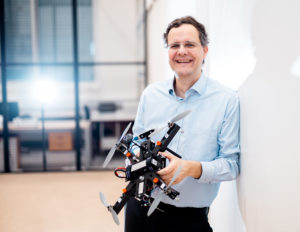Keynote at the IEEE Intern. Conf. on Autonomic Computing and Self-Organizing Systems (ACSOS), Aarhus, Denmark, September 18, 2024
Abstract
Synchronization and swarming are two phenomena of self-organization in nature that are also relevant to engineering. In multi-robot systems, for example, temporal coordination is needed for tasks such as cooperative sensing and wireless communication; at the same time, mobile robots must be coordinated in the spatial domain to perform collaborative tasks. Recent research aims to develop a unified theory for synchronization and swarm behavior that accounts for their interplay. Entities that exhibit both phenomena are called “swarmalators.”
This keynote explores the use of swarmalators in robotics and related fields. The presentation first introduces the concept of self-organized synchronization, including its prevalence in natural systems, modeling with pulse-coupled oscillators, and its transfer to wireless systems. We then explain the coupling of synchronization with swarming and discuss the challenges of applying the swarmalator theory to technology. To demonstrate practical feasibility, we present prototypes of engineered swarmalator systems using mobile robots and drones. The talk concludes with emerging topics, providing insight into research directions in the field.
Speaker bio

Photo by D. Waschnig / U Klagenfurt
Christian Bettstetter is a professor of mobile systems and heads the Institute of Networked and Embedded Systems at the University of Klagenfurt, Austria. Additionally, he serves as the scientific director of Lakeside Labs, a research and innovation company. He earned his doctoral degree (summa cum laude) in electrical engineering and information technology from TU Munich, Germany. Bettstetter leads a team focusing on wireless communications and self-organization in networked systems. Their work has applications in telecommunications, IoT, and mobile robotics. He also coordinates an interdisciplinary research cluster on self-organizing systems and is a faculty member in the Karl Popper school on networked autonomous aerial vehicles. He has received several scientific awards, including the Best Paper Awards at SASO 2019 and ACSOS 2021. His commitment to teaching was recently recognized with the university’s Excellence in Teaching Award.
